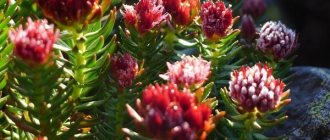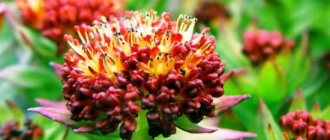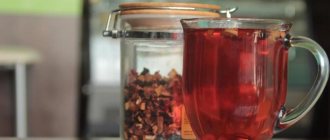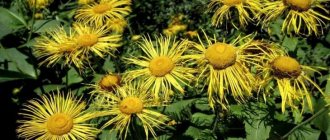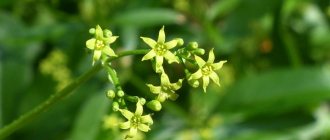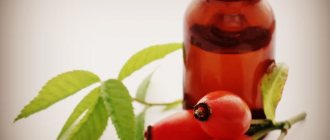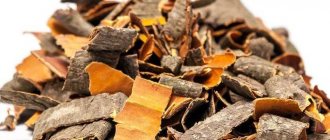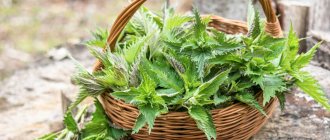Rhodiola rosea (pink, golden root) is a herbaceous perennial plant from the Crassulaceae family. It has a distinctive feature: the root and rhizomes are the color of bronze or old gilding with a noticeable pearlescent sheen, due to which it received its second “precious” name. The plant is included in the Red Book of the Russian Federation.
It is found in regions with temperate and cold climates, including Great Britain, North America and Ireland, grows well in alpine mountain meadows (in the Pyrenees, Alps, Carpathians), found in Kazakhstan, grown in China, Bulgaria, India. In the Russian Federation it is found in Altai and the Urals, in the mountainous regions of the Far East, Eastern and Western Siberia, in the polar regions of Yakutia, on the coasts of the Barents and White Seas. The plant is undemanding to light and heat, but needs plenty of moisture. It grows on rocks and rocky outcrops, in flat tundra, on the banks of mountain rivers and streams.
It has long been used in folk and official medicine as an effective adaptogen that increases resistance to adverse environmental factors, as well as a stimulant of the central nervous system. Part of the group of adaptogens, it combines and competes with eleutherococcus and ginseng.
Morphological description
The rhizome is horizontal, powerful, covered with a brown (bronze) cork, and has thin adventitious roots. When broken, the root is white, has a bitter-astringent taste, and has a special aroma, similar to the smell of a rose.
Most often, the plant has several (10-15 pieces) non-branched erect stems, 10-40 cm high, less often there is only one stem. The leaves are alternate, sit on stems, have an oblong-ovate, elliptical or pointed shape with a whole or serrate-toothed upper part.
Flowering occurs in June-July, fruits reach maturity in July-August. The inflorescence is multi-flowered and has a corymbose shape. The flowers are yellow, unisexual, four-, less often five-membered. The fruits are erect, multi-leafed, green.
Propagated both by seeds and vegetatively.
Collection, preparation and reproduction
The root of Rhodiola rosea is harvested for future use (the plant is 3-4 years old). This is done between the end of July and September. The roots are dug up, thoroughly washed to remove soil particles in cool water, and cleaned of brown plugs and rotten, dry areas. Cut the rhizome into pieces, each 10 cm long, and dry them at 50 degrees in a dryer.
The finished raw material has a pinkish or white color when broken. If the root is brown in color at the break, it is unsuitable for use because it loses its beneficial properties. Store dry raw materials in canvas bags in a dark place. Shelf life – 3 years.
Most often, the plant is propagated by seeds: planted in late autumn or winter in a box with nutritious soil, providing good ventilation (expanded clay is placed on the bottom). The soil is pre-moistened with a weak solution of potassium permanganate and compacted a little. The seeds are evenly distributed over the surface and lightly pressed, covered with soil (2 mm layer), covered with film and placed on the balcony. In March, the box is moved to a warm, illuminated place, and within a couple of days shoots will appear. They can be replanted when two true leaves appear.
You can propagate a plant (which is at least 2 years old) by dividing the rhizomes into 2 parts, which are planted in prepared holes with humus; compost is also laid on top, leaving renewal buds on the surface.
Preparing the tincture
There are many recipes for preparing tinctures from the root of the plant.
Recipe No. 1:
- The root is poured with 40% alcohol in a ratio of 1:2.
- Leave in a dark place for one week.
- Take ten drops three times a day before meals.
Recipe No. 2:
- The root is crushed and filled with 40% alcohol in a ratio of 2:1.
- Leave for twenty-five days and filter.
- Take ten drops three times a day.
Recipe No. 3:
- The roots of the plant are poured with vodka in a ratio of 1:2.
- Infuse for twenty days in a dark and cold place.
- Take ten drops three times a day.
Chemical composition
The root of the plant contains more than 140 useful elements, which determine the complex positive effect.
- Phenols and their derivatives: tyrosol, salidroside. Strengthen the circulatory system, protect blood vessels from narrowing. Prevents cholesterol oxidation;
- Carbohydrates: glucose, fructose, sedoheptulose, sucrose. Participate in energy metabolism;
- Organic acids: oxalic (stimulates gastric secretion and intestinal function),
- apple (normalizes digestion, improves the condition of blood vessels, improves vision and is involved in metabolism),
- amber (neutralizes free radicals, reduces uric acid levels, restores joint mobility, stimulates insulin production),
- lemon (increases appetite, stimulates cell renewal, activates the immune system);
Straight chain aliphatic alcohols and monoterpene hydrocarbons were found in the essential oil. The composition of the essential oil varies depending on where the plant grows.
The aboveground part of the plant is saturated with organic acids (malic, citric, oxalic, succinic), phenols and their derivatives, phenolcarboxylic acids (gallic, caffeic), coumarins, tannins, and flavonoids.
Beneficial features
Golden root (rhodiola) is characterized by many beneficial properties:
- is a powerful antioxidant and adaptogen;
- protects the body from the development of cancer and prevents tumor metastasis;
- increases blood pressure;
- improves heart function;
- fights pathogenic microorganisms;
- has an anti-inflammatory effect;
- promotes bile secretion;
- stops bleeding;
- restores the body after overwork, tones well;
- has a general strengthening effect and increases the body’s resistance to the influence of unfavorable environmental factors;
- has a neuroprotective effect;
- stimulates the central nervous system;
- maintains the energy potential of the brain at a high level;
- improves cognitive functions;
- accelerates the course of oxidative processes;
- accelerates wound healing.
Scientific research
Scientific research began in the 60s of the 20th century. In 1961, an expedition led by G.V. Krylov was carried out, during which scientists managed to find the plant in the taiga of the Altai Mountains. Based on research results, the plant was introduced into scientific medicine and began to be used in the form of a liquid extract with adaptogenic and stimulating properties.
Numerous studies have been conducted to study the effect of the plant on the central nervous system. Plant preparations change the bioelectrical activity of the brain and improve cognitive functions: by increasing resistance to stress factors, memory and the ability to remember information improves.
The positive effect of plant preparations has been reported to eliminate the side effects of psychotropic therapy for schizophrenia.
A number of studies have shown that roseola rosea can improve physical performance. An experiment conducted on animals (white rats) recorded a decrease in the rate of glycolysis, the amount of lactic acid in the muscles, the preservation of a high level of phospholipids in the muscles and liver, as well as blood sugar after 2 hours of swimming in individuals receiving the plant preparation.
The possibility of using plant preparations as hepatoprotectors is also being considered. The effectiveness of use as a therapeutic and prophylactic agent for liver damage induced by organophosphorus compounds has been proven in animals.
Application
Rhodiola rosea is a powerful adaptogen that has a visible effect after the first use of the drug! But you can’t take plant preparations every day without reason. Constant stimulation of the body, even with herbal preparations, can lead to an effect opposite to the expected one.
Rhodiola is used for many diseases and pathological conditions, and is characterized by a whole range of pharmacological properties. The most common indications for the use of plant preparations:
- poor appetite;
- metabolic disorders;
- physical and mental fatigue;
- VSD;
- neuroses;
- asthenic condition after long-term illnesses;
- inflammatory processes;
- allergic reactions;
- radiation injuries (acute and chronic);
- reduced visual acuity;
- poor hearing;
- pulmonary tuberculosis;
- anemia;
- oncological diseases;
- bone fracture;
- menorrhagia;
- dysmenorrhea;
- amenorrhea primary and secondary;
- gynecological diseases (adnexitis, polycystic ovary syndrome, fibrocystic mastopathy);
- early menopause;
- impotence;
- oligospermia;
- late puberty;
- toothache;
- headache;
- gout;
- diabetes;
- conjunctivitis;
- angina;
- pyorrhea;
- diarrhea;
- wounds, skin lesions, rashes, abscesses.
Golden root is often used for men and women: it helps with impotence and is indicated for many diseases of the female reproductive system. Plant preparations enhance the functioning of the sex glands, stimulate the ovaries and are widely used in the treatment of early menopause. The plant has a positive effect on potency, and its effectiveness is higher than that of ginseng root.
It has been proven that the plant enhances the effect of cytostatics that cause necrosis of cancer cells: the membrane, core and parts of the cell are destroyed, which leads to its death.
Contraindications for use
In some cases, the plant is prohibited from being taken. Such cases include:
- high susceptibility to the plant;
- hypertonic disease;
- strong stimulation of the nervous system;
- brain pathologies;
- convulsions;
- children under twelve years of age;
- the period of bearing and breastfeeding a child.
The tincture must be used in limited quantities; an overdose of the drug can lead to negative consequences, including death.
In cosmetology
This unique plant has also found its application in cosmetology. Golden root extract has a positive effect on aging, sensitive skin and improves its overall condition. The rich biologically active composition allows the use of plant extracts in various creams to give them stimulating and adaptogenic properties, slow down the aging process of the skin, and increase resistance to adverse environmental factors.
Cosmetic preparations with golden root:
- normalize metabolic processes in the skin;
- improve energy metabolism in cells;
- accelerate skin regeneration processes;
- minimizes transepidermal fluid loss;
- increase skin barrier functions;
- slow down the aging process;
- reduce the level of depression.
The most popular cosmetics with golden root: day cream for sensitive skin from “Natura Siberika”, face cream “Clean Line”, day cream “Granny Agafya’s Recipes”.
Pharmacological properties
Rhodiola rosea exhibits many medicinal properties. It can stop the development of many diseases, increase the body's defenses, and improve brain activity. The roots of the plant have hypotensive, choleretic, hemostatic, anti-inflammatory, as well as analgesic, tonic, wound-healing and calming effects.
Rhodiola normalizes blood pressure, stops the development of stroke and atherosclerosis, normalizes liver function, eliminates anemia, activates the process of tissue regeneration, normalizes body temperature, eliminates viral and infectious diseases, stabilizes the functioning of the gastrointestinal tract, and also improves appetite, removes toxins, and has a calming effect on the nervous system. system, helps overcome mental disorders.
Rhodiola root tincture normalizes metabolism, blood sugar levels, eliminates swelling, stops the growth and development of cancer cells, accelerates the process of bone tissue restoration in case of fractures, gives vigor and strength, improves the acuity of the sensory organs, stops bleeding, normalizes the activity of the hormonal system, increases libido .
Pharmaceutical preparations with Rhodiola rosea
Golden root has also found application in official medicine - many drugs and dietary supplements are actively used in the treatment of a number of diseases. Let's look at the most popular ones.
Rhodiola Liquid ExtractThe drug is indicated for increased fatigue, neurocirculatory dystonia of the hypotonic type, neurasthenic conditions, during the period of recovery from severe somatic and infectious pathologies, during periods of mental and physical stress, and also as a means for the prevention of acute respiratory viral infections during periods of epidemics. |
Rhodiola +A dietary supplement recommended for raising tone, increasing performance (mental and physical), and strengthening resistance to adverse environmental factors. |
Rhodiola rosea vis extract in capsules
|
Root
|
The plant is also included in various herbal teas and mixtures.
Dosage forms and doses
The medicine from Rhodiola rosea must be taken in limited quantities and strictly according to the instructions.
How to take medications correctly depends on their form. The plant is presented on the pharmacological market in the form of tablets, tinctures, and extracts. The tincture is taken in an amount of five to ten drops diluted in half a glass of water. The last dose of medication is taken four hours before bedtime.
The extract is taken in the amount of ten drops three times a day. It treats colds, asthenic syndrome, and fatigue. The course of therapy is twenty days. If a person has mental disorders, he is prescribed thirty drops of radiola extract.
The tablets contain Rhodiola extract. Take them in the amount of two pieces per day. In this case, the pills should be taken in the first half of the day. The course of therapy should not exceed twenty days. If necessary, the course is repeated after two weeks.
Traditional recipes with Rhodiola rosea
Traditional healers have long and successfully used plant preparations for many diseases. The duration of use is determined individually, but it is recommended to take no more than 5 days in a row, after which take a seven-day break.
Tincture of golden root with vodka for hypotension
- Take 50 gr. dry plant root, grind to a powdery consistency, pour in 2 glasses of vodka. Leave in the dark for 14 days, shake occasionally. Strain the finished tincture.
- Take 20-30 drops 3 times a day. 30 minutes before meals. You can start taking 5 drops and gradually increase the volume to the recommended amount.
Tincture of golden root for colds and heart weakness, nervous diseases and pathologies of the gastrointestinal tract
- Take 10 g. roots, chop and pour 1 cup of boiling water. Leave to brew for 4 hours and strain.
- Take half a glass 3 times a day. Externally used as an effective wound healing agent for treating wounds, cuts, and for rinsing the mouth during sore throat.
Decoction
- Improves the functioning of the heart and blood vessels, making them more resilient. Helps with gastrointestinal diseases, uterine bleeding, impotence, improves thyroid function and normalizes blood sugar levels. Eliminates headaches and toothaches. Can be used externally to wipe the skin.
- Take 20 gr. roots, chop and pour 500 ml of boiling water, keep on low heat for 10 minutes. Leave to steep until cool, then strain.
- Take 50 ml 3 times a day.
Tonic decoction
- It has a strong stimulating effect on the central nervous system, which surpasses the effect of black teas and coffee. Therefore, you should not take it every day, but only when necessary.
- Take 1 tsp. root (pre-crushed) and pour 1 liter of water, boil for 10 minutes. and leave for another 40 minutes. in a warm place.
- Take 2-3 glasses during the day (no later than 4 hours before going to bed), adding sugar or honey to the drink if desired.
Collection to strengthen immunity
- Take 20 grams. Rhodiola roots, rose hips and zamanika roots. Add 15 gr. hawthorn fruit, 15 gr. dry nettle, 10 gr. St. John's wort herb, mix. 1 tbsp. pour a glass of boiling water over the collection and place on low heat for 10 minutes. Leave to infuse for 4 hours, covered, and strain. Dilute the resulting volume with 200 ml of boiling water.
- Take 70 ml 3 times a day.
Tincture for anemia and diseases of the female reproductive system
- It also helps with age-related loss of strength, impotence, pulmonary tuberculosis, liver pathologies and diabetes.
- Take 100 gr. chopped roots and pour 400 ml of good vodka over them. Place in a dark place for 7 days.
- Take 30-40 drops 3 times a day. 30 minutes before meals.
Collection for colds and gastrointestinal disorders
- Take equal parts of Rhodiola rosea, bergenia, blackberry, strawberry, raspberry, black currant leaves, cinquefoil flowers, St. John's wort flowers and thyme, mix everything. Take 3 tbsp. dry collection and pour 1 liter of boiling water over them, leave for 60 minutes. Add honey or sugar to taste.
- Take 1-2 glasses per day.
Indications for use
Rhodiola rosea is a unique plant; tinctures from it are used to treat many pathologies and disorders. These include:
- Colds. When the body is severely hypothermic, a cold develops, which is accompanied by the development of infection and virus. These are diseases such as acute respiratory viral infections and acute respiratory infections, influenza. Rhodiola helps increase the body's defenses and eliminate fever.
- VSD. With vegetative-vascular dystonia, the activity of the nervous system is disrupted. A tincture from the root of the plant has a calming effect, it eliminates anxiety, pain in the heart area, and normalizes the functioning of the gastrointestinal tract.
- Chronic fatigue syndrome. The plant improves tone, has an antioxidant effect, gives vigor and strength.
- Diabetes mellitus, which is accompanied by disruption of the endocrine system. Rhodiola reduces blood sugar levels.
- Depression. The plant is taken as part of complex therapy for the treatment of depression. The plant helps strengthen the body, has a sedative effect, and eliminates fears and anxieties.
- Externally, tincture of Rhodiola root is used for wound healing, and also as a disinfectant, analgesic and anti-inflammatory agent.
- Oncological diseases.
- Diseases of the reproductive system.
VSD
In case of VSD, Rhodiola rosea normalizes the activity of the nervous system; tincture from it helps to increase the body's resistance to stress, eliminate emotional stress, and has a relaxing effect.
Taking plant-based medications will alleviate a person’s condition and contribute to his recovery.
Depression
Rhodiola improves mood, increases the body's endurance, and fights depression. The root of the plant contains essential oils, manganese, glucose and proteins, which help normalize the mental state. For depression, decoctions, teas and tinctures from the plant are taken.
Hypertension
Although radiola rosea has various effects and can stop the development of many diseases, it is not recommended for use for hypertension. With high blood pressure, tincture from the root of the plant contributes to the development of side effects such as migraines and hypertensive crisis.
Mastopathy
Rhodiola is used in the complex therapy of mastopathy. It is recommended to take a tincture from the root of the plant as a preventive measure. To do this, I drink a few drops of it twice a day. The tincture is also used for compresses, adding it to sea buckthorn oil, carrots and beets. The compress is applied several times over the course of two weeks.
Diabetes
Rhodiola effectively reduces blood sugar levels. It is recommended to take the tincture from the plant for ten days. As a preventive measure, it is consumed in the amount of fifteen drops daily for a week.
Do not exceed the dosage of the medicine, as it can cause the development of side effects.
